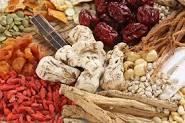












CARAWAY
Carum carvi
FAMILY Apiaceae (Umbelliferae)
SYNONYMS Apium carvi, carum, caraway fruits.
GENERAL DESCRIPTION
A biennial herb up to 0.75 metres high with a much-branched stem, finely cut leaves and umbels of white flowers, with a thick and tapering root. The small seeds are curved with five distinct pale ridges.
DISTRIBUTION
Native to Europe and western Asia, naturalized in North America. Now widely cultivated especially in Germany, Holland, Scandinavia and Russia.
OTHER SPECIES
There are several varieties depending on origin - the English, Dutch and German types derive from Russia, which are distinct from the Scandinavian variety. Those plants grown in northerly latitudes produce more oil..
HERBAL/FOLK TRADITION
Used extensively as a domestic spice, especially in bread, cakes and cheeses. Traditional remedy for dyspepsia, intestinal colic, menstrual cramps, poor appetite, laryngitis and bronchitis. It promotes milk secretion and is considered specific for flatulent colic in children, according to the British Herbal pharmacoppeia.
ACTIONS
Antihistaminic, antimicrobial,antiseptic,aperitif,astringent, carminative,diuretic,emmemagogue, expectorant,galactagogue, larvicidal,stimulant, spasmolytic, stomachic, tonic, vermifuge.
EXTRACTION
Essential oil by steam distillation from the dried ripe seed or fruit (approx 2-8 per cent yield).
CHARACTERISTICS
Crude caraway oil is a pale yellowish-brown liquid with a harsh, spicy odour. The redistilled oil is colourless to pale yellow, with a strong, warm, sweet-spicy odour, like rye bread. It blends well with jasmine, cinnamon, cassia and other species, however, it is very overpowering.
PRINCIPAL CONSTITUENTS
Mainly carvone (50-60 per cent) and limonene (40 per cent),with carveol, dihydrocarveol, dihydrocarvone,pinene, phellandrene, among others.
SAFETY DATA
Non-toxic, non-sensitizing, may cause dermal irration in concentration.
AROMATHERAPY/HOME USE
Respiratory system: Bronchitis, coughs, laryngitis
Digestive system: Dyspepsia, colic, flatulenc, gastric spasm, nervous indigestion, poor appetite, see also sweet fennel and dill.
Immune system: Colds.
OTHER USES
Used in carminative, stomachic and laxative preparations and as a flavour ingredient in pharmaceuticals; also to mask unpleasant tastes and odours. Fragrance component in toothpaste,mouthwash products, cosmetics and perfumes.
Extensively used as a flavour ingredient in most major food categories, especially condiments. The German brandy'Kummel'is made from the seeds.
Reference: The Encyclopedia of Essential oils: Julia Lawless
Articles Latest
- Chamomile Roman - Chamaemelum nobile
- Chamomile Maroc - Ormenis multicaulis
- Chamomile German - Matricaria recutica
- From Biology To Aromatherapy
- Plant Messengers
- Celery Seed-Apium graveolens
- Cedarwood Virginian - Juniperus virginiana
- Cedarwood, Texas- Juniperus ashei - Essential oils
- Cedarwood Atlas- Cedrus atlantica - Essential Oils
- Cassie - Acacia Farnesiana - sweet acacia
- Cassia - Cinnamomum Cassia
- Cascarilla Bark - Croton eluteria
- Carrot Seed- Dacus Carota
- CARDAMON
- CARAWAY
- CANANGA
- CAMPHOR
- CALAMUS
- Calamintha-Calamintha officinalis
- CAJEPUT- Melaleuca cajeputi
- Plant Expression
Articles-Most Read
- Home
- Balsam Canadian - Abies balsamea
- Balsam Peru
- Copaiba Essential Oil
- North America: Tea Tree and Monarda-3
- Basil French - Ocimum basilicum
- Basil Exotic
- North America: Tea Tree and Monarda-2
- Exploring Transcultural Constants
- Thyme Essential Oil
- Balsam Tolu
- Palma Rosa
- The Bioactivity of Essential Oils
- Bay - West Indian - Pimenta racemosa
- Benzoin - Styrax benzoin
- Why Pharmacology Cannot Demonstrate Essential Oil Efficacy
- Exploring Essential Oil Activity The Conventional Way
- Complex information From Plants
- Aromatherapy: An Answer
- Contacts
